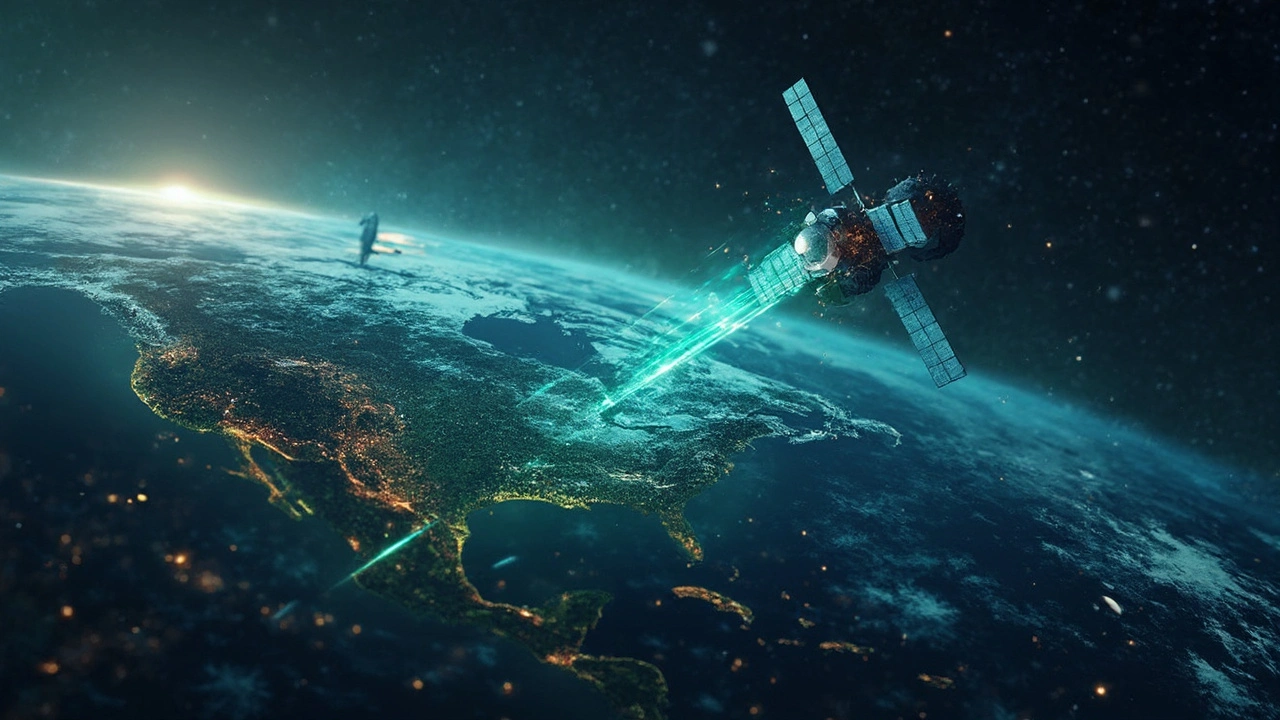Ever wondered what those bits of tech floating around Earth are busy doing? Despite zipping miles above us, satellites have a huge impact on our daily lives. They might seem like something out of a sci-fi movie, but they play a crucial role in things we often take for granted.
Take snappy text messages or seamless FaceTime calls, for instance. Ever think about the magic that makes that happen? Yep, it’s those satellites up there ensuring the lines stay clear and quick. Beyond communication, they’re pivotal in other fields too, like helping us check the weather. You know when your weather app nails tomorrow's forecast? A weather satellite probably had a hand in that.
And don't get me started on GPS. Whether you're trying to find the quickest route to the beach or locate your friend at a music festival, satellites keep those maps accurate and up-to-date. So next time you wonder about your everyday conveniences, tip your hat to the satellites beaming all this data, shaping how we connect, navigate, and understand our world.
- Introduction to Satellites
- Communication Satellites
- Weather Monitoring Satellites
- Navigation and GPS
- Earth Observation and Research
- Future of Satellites
Introduction to Satellites
So, what's the deal with these space satellites everyone keeps talking about? Basically, they're like high-tech machines zipping around Earth, each doing its own unique job. We’ve launched thousands of them since the 1950s, and you can find them in different orbits, solving countless problems.
Types of Orbits
Satellites don’t just hang out randomly. They follow specific paths known as orbits. You have the low Earth orbit (LEO), ideal for those really detailed Earth photos. Then there’s the geostationary orbit, where satellites move with Earth's rotation, perfect for keeping an eye on the weather and broadcasting TV. And don’t overlook the medium Earth orbit (MEO), most famous for navigation satellites like the GPS.
How Satellites Work
Ever think about how a satellite actually functions? Well, they mainly rely on solar panels to power up and antennas to send and receive information. Inside, they've got everything from cameras to scientific instruments depending on their job. It's like an all-in-one tech hub floating in space.
Interesting Launch Facts
How do these giants get into space? Rockets. It’s a heart-pounding experience to watch a launch, with satellites tucked safely inside the rocket's nose. Once in space, they pop out and head to their designated orbits.
And here's a cool tidbit – satellites aren't just plain lumps of metal. They vary in size too! The smallest ones, known as CubeSats, weigh not much more than a couple of soda cans, while the largest can be as big as a school bus!
Communication Satellites
So what's the deal with communication satellites? They're basically the backbone of global connectivity. Whether you're posting silly TikToks, hosting a virtual meeting, or catching up on the latest streaming series, these satellites are busy bouncing your data through space and back with lightning speed.
Communication satellites work by retransmitting signals from one point on the Earth to another. Imagine them as giant mirrors, catching signals and relaying them back, but way more high-tech.
Understanding How They Work
These satellites are typically parked in geostationary orbit. That means they hover over the same spot on Earth, about 35,786 kilometers up. This positioning is crucial for providing consistent signal coverage, particularly over large areas where traditional infrastructure would be tough to build.
They contain transponders, which are just fancy radios, that both receive and transmit. These transponders can handle various frequencies, supporting everything from phone calls to television broadcasts.
Why They're Essential
- Global Communication: They link even the remotest corners of the planet, crucial for regions without robust ground-based networks.
- Emergency Services: When natural disasters knock out local communication, satellites are often the heroes, helping coordinate rescue and relief.
- Broadcast and Media: They let networks beam live events to billions around the globe, bringing world events into our living rooms.
Fun Fact
Did you know the first communication satellite, Telstar 1, was launched in 1962? It paved the way for such massive tech growth that now, over 2,000 communication satellites are in orbit!
So next time you're streaming a show or chatting with someone far away, remember it's those tireless satellites that keep us all connected. They're what make the world feel like one big, interconnected neighborhood.
Weather Monitoring Satellites
Alright, let's dive into how these space gadgets keep us updated on Mother Nature’s moods. Weather monitoring satellites are the unsung heroes behind the accurate forecasts you check every morning.
How They Work
Weather satellites orbit around our planet, capturing data like temperature, cloud patterns, and storm formations. They essentially take the planet’s pulse from space, using sensors that can pick up even the tiniest changes in the atmosphere.
The data they send down helps meteorologists predict everything from sunny days to disastrous hurricanes, giving people on the ground time to prepare.
Types of Weather Satellites
There are basically two types: geostationary and polar-orbiting. Geostationary satellites hover over a fixed spot near the equator, while polar-orbiting ones zoom around the poles and can cover the entire globe as the Earth rotates. Each has its own job to do—kind of like the difference between a supervisor who oversees day-to-day operations (that’s geostationary) and a detective solving mysteries by gathering clues from all over (that’s polar).
Measuring Impact
Our everyday weather apps? Totally reliant on this satellite data. In fact, a study showed that 90% of the information used in weather predictions comes from these space-based systems. Imagine packing for a camping trip with just guesswork about the weather—yikes!
| Type of Satellite | Main Function | Coverage |
|---|---|---|
| Geostationary | Real-time monitoring | Fixed spot over equator |
| Polar-Orbiting | In-depth analysis | Global coverage |
So next time you're planning an outdoor event, or wondering whether to bring an umbrella, remember those tiny tech geniuses whizzing above our heads. They’re working around the clock to keep us one step ahead of the weather!

Navigation and GPS
You might assume getting from point A to point B is as easy as following a blue line on your phone screen, but there are space satellites at work behind the scenes playing a crucial role. At the heart of today's navigation is the Global Positioning System (GPS). Launched by the U.S. Department of Defense in the late 1970s, the GPS has become the backbone of location-based services we rely on daily.
Ever get lost in a new city and marveled at how quickly your phone tracks your every move? That's thanks to a fleet of 31 active GPS satellites orbiting Earth. These satellites send time-stamped signals to GPS receivers in your phone or car. By calculating the time it takes for the signal to travel, your device determines your exact location.
How GPS Helps Us
Whether it's directing a delivery driver to your doorstep or staking claim to the best fishing spots with precision, GPS does a lot more than just guide you on road trips.
- Navigation: From everyday commutes to international flights, GPS helps pinpoint the best routes, saving time and fuel.
- Emergency Response: First responders use GPS to quickly reach accident scenes, potentially saving lives.
- Scientific Research: Researchers use GPS data for geologic studies, like tracking tectonic plate movements.
Fun Fact
Did you know that while the U.S. GPS is the most well-known, there are other systems like Russia’s GLONASS, Europe’s Galileo, and China’s BeiDou, all keeping the world connected?
A statement from the National Coordination Office for Space-Based Positioning, Navigation, and Timing explains, "GPS provides critical positioning capabilities to military, civil, and commercial users around the world. In fact, GPS operating worldwide continuously, freely, and accurately is the crust of navigation."
So next time your phone effortlessly guides you to your destination, give a little nod to the trusty space satellites zipping above, working hard to keep us all on track.
Earth Observation and Research
When you hear about earth observation, it’s more than just looking down from a sky-high spot. Satellites are like the planet’s personal paparazzi, capturing images and data that are essential for understanding our environment. They’ve got eyes everywhere — oceans, forests, cities, and polar ice caps.
Why do we need this constant observation? For starters, changes in our environment can happen gradually or suddenly, and satellites help scientists spot trends. Take deforestation, for instance. It’s tricky to track from the ground but a breeze from space. Satellites provide consistent monitoring of forest cover, which in turn helps us manage natural resources better.
Weather satellites, as part of earth observation, also play a key role in tracking phenomena like hurricanes and cyclones. Satellites can monitor weather conditions and predict extreme events long before they hit, giving communities time to prepare and stay safe. It’s pretty cool how they’ve become lifesavers in this sense.
Scientific Research
Beyond weather and nature, these satellites contribute massively to scientific research. They help measure sea levels rising, a crucial indicator of climate change, and track glacier movements in those chilly polar regions. Knowing how these natural elements shift over periods keeps scientists ahead in understanding our planet’s future.
Bet you didn’t think of satellites as pollution detectors. But they sure are! Satellites equipped with special sensors can detect pollutants and track air quality. Cities worldwide utilize this data to devise policies aiming to reduce urban air pollution.
And the fun fact? Some of these satellites circle the globe every 90 minutes, sending back real-time data that’s genuinely shaping our understanding of Earth’s dynamics.
| Aspect | Role of Satellites |
|---|---|
| Deforestation | Monitor forest cover, detect illegal logging |
| Weather Patterns | Predict storms, monitor temperatures |
| Pollution | Track air quality, detect pollutants |
So, next time you read about new scientific discoveries about our planet, remember the satellites tirelessly orbiting above, capturing everything they can!
Future of Satellites
Satellites are no longer new kids on the block; they’ve been around for a while, proving their worth. But what about the future? Well, it's looking bright and packed with innovations. Space technology is advancing faster than ever, giving satellites new roles and capabilities.
Miniaturization and New Satellites
One big trend is miniaturization. Smaller satellites, often called CubeSats, are popping up more. They're cheaper to launch and can work in flocks, performing tasks together. Imagine a swarm of satellites scanning the Earth more efficiently!
Internet from Space
Heard about satellite internet? Companies like SpaceX are deploying large groups, or constellations, of low Earth orbit satellites to provide global internet coverage. This can make fast internet accessible in remote areas, a total game-changer!
Environment Monitoring
Satellites will likely step up in climate change efforts. They can track deforestation, melting ice, and even help predict natural disasters better. By monitoring Earth closely, we might handle environmental challenges more effectively.
Increased Commercial Uses
Businesses are starting to see the potential. Satellites can do more than broadcast TV. They aid in precision agriculture, logistics, and even tracking endangered species. Talk about versatility!
| Year | Satellite Innovation |
|---|---|
| 2025 | First fully AI-operated satellite launches |
| 2030 | Widespread satellite internet adoption |
The future of space satellites is buzzing with possibilities. From better communication to advanced environmental solutions, these floating machines will continue to redefine how we connect and interact with our planet.

